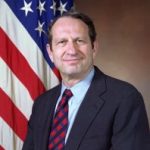War By Other Means
On March 14, 2019, the Senate Armed Services Committee held a hearing on the budget for the Defense Department. Acting Defense Secretary Patrick Shanahan and General Joseph Dunford testified. When it was Senator Josh Hawley’s turn to ask questions, he asked about Google. The following is a clip of the question and answer.
On June 21, 1993, John Gibbons, the Director of the White House Office of Science and Technology Policy testified at a hearing of the Congressional Joint Economic Committee to lay out the Clinton-Gore technology policy for congress. His testimony is critically important because it was the implementation of the policy that Gibbons articulated that put us where we are today.
There was a technology plan that went along with Gibbon’s testimony. The following is an excerpt from the report concerning the funding and requirement for the National Laboratories to work with the private sector in the development of technologies and to provide funding for the Universities and Extension Centers to do the same.
National Laboratories and Universities
GOAL: WORLD LEADERSHIP IN BASIC SCIENCE, MATHEMATICS, AND ENGINEERING
University Research
National Laboratories
Space Science and Exploration
Environmental Research
It is essential to recognize that technical advances depend on basic research in science, mathematics, and engineering. Scientific advances are the wellspring of the technical innovations whose benefits are seen in economic growth, improved health care, and many other areas. The federal government has invested heavily in basic research since the
Second World War and this support has paid enormous dividends. Our research universities are the best in the world; our national laboratories and-the research facilities they house attract scientists and engineers from around the globe. In almost every field, United States researchers lead their foreign colleagues in scientific citations, in Nobel prizes, and most other measures of scientific excellence.
University Research. The National Science Foundation and the National Institutes of Health provide the vast majority of Federal funding for university research. Since universities play dual roles of research and teaching, the long-term scientific and technological vitality of the U.S. depends upon adequate and sustained funding for university research grant programs at NSF, NIH, and other research agencies.
National Laboratories. In fields like high-energy physics, biomedical science, nuclear physics, materials sciences, and aeronautics, the national laboratories provide key facilities used by researchers in academia, Federal labs, and industry. In addition, in many fields, researchers at Federal labs are world leaders. We will ensure that Federal laboratories continue their key role in basic research and will encourage more cooperative research between the laboratories and industry and universities. And we will develop new missions for our federal labs to make full use of the talented and experienced men and women working there in today’s post-cold war era.
Environmental Research. In FY93, the Federal government will invest in research to better understand global warming, ozone depletion, and other phenomena important to local, regional, and global environments. This research is essential if we are to fully assess the damage mankind is doing to our planet and take effective action to address it. Vital research on local and regional environmental problems will also be strongly supported at EPA, NOAA, NASA, DoD, DOL, USDA, and other agencies.
BUILDING AMERICA’S ECONOMIC STRENGTH: NEW INITIATIVES
· Permanent Extension Of The Research And Experimentation Tax Credit
· Invest In A National Information Infrastructure
· Advanced Manufacturing Technology
· Facilitate Private Sector Development of a New Generation of Automobiles
· Improve Technology For Education And Training
· Investments In Energy-Efficient Federal Buildings
For all of those activities, the federal government has provided funding for the private sector for research and development of technologies which it then gifts to the researchers. Money for research and development through grants and tax credits was provided not just to the top research universities, but to every institution that hangs a shingle on the door indicating that some education is happening somewhere inside. Not only that, the State Department opened the flood gates for an unlimited number of students from foreign countries to come to the U.S. to be educated in our universities.
The following is a video produced by Vince Wade. Vince had been in broadcasting and he was from the state of Michigan so he was very familiar with what was happening there at the University of Michigan.
Even the military’s budget for research and development was re-directed away from military purposes to civilian purposes – technology for the police state.
Partnership Between DOJ and DOD
1994 – NCJ 164268 – “Partnership” Between Law Enforcement and the Military
“In 1994 the U.S. Department of Justice (DOJ) and the U.S. Department of Defense (DOD) entered into a cooperative agreement to develop technologies of value to both. This agreement, codified in a Memorandum of Understanding (MOU) and signed by the Deputy Secretary of Defense and the Attorney General, formalized and focused a longstanding ad hoc relationship. To manage this technology development program and to direct its day-to-day activities, the MOU established a Joint Program Steering Group (JPSG) that would represent both departments and be staffed with members from several agencies.”
In 1997, a report was produced on the progress of the DOD-DOJ cooperative research and development projects.
This report is about the Army’s Public-Private Partnerships. It’s important because between the lines, there is an obvious strategy to de-militarize the military:
Rand: “Seeking Nontraditional Approaches to Collaborating and PARTNERING with Industry”
On the Federation of American Scientists website, there is a page on all the defense hearings held by Congress in 1997. On June 17, 1997, there was a hearing of the Joint Economic Committee. The title of the hearing was Economic Espionage, Technology Transfers and National Security. A Wall Street Journal Reporter, John Fialka testified at that hearing about his research and a book he wrote about it titled, War By Other Means: Economic Espionage. A search through the C-Span archives turned up an interview that Mr. Fialka gave about his book. This is the video:
JANUARY 21, 1997
War By Other Means: Economic Espionage
Mr. Fialka talked about his new book, War By Other Means: Economic Espionage in America, published by W.W. Norton and Company. He recounts many real-world spy stories and warns U.S. industry about the risks of economic espionage. He talks about security and the theft of patents and software by electronic means.
They’ve all had a lot of fun in Washington DC and they’ve all made a lot of money while the domestic economy was being bled out and the American workforce crushed but maybe just maybe the meaning of War in the Context of Everything Else is beginning to penetrate their armored skulls. The enemy isn’t just out there, the enemy is also in here. They are in the National Laboratories, the Universities and they are in the halls of government. They’ve nearly killed the golden goose and now China is getting the golden eggs. We’ve been waiting for a return of serious adults (real Americans) to the beltway. Maybe this is the time? Maybe this year?
___
http://thetechnocratictyranny.com/corruption/war-by-other-means/



